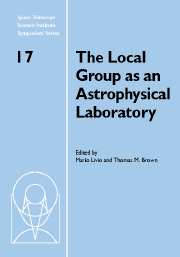 The Local Group as an Astrophysical Laboratory
The Local Group as an Astrophysical Laboratory Book contents
- Frontmatter
- Contents
- Participants
- Preface
- History of the Local Group
- Primordial nucleosynthesis
- Galactic structure
- The Large Magellanic Cloud: Structure and kinematics
- The Local Group as an astrophysical laboratory for massive star feedback
- Hot gas in the Local Group and low-redshift intergalactic medium
- Stages of satellite accretion
- The star formation history in the Andromeda halo
- Bulge populations in the Local Group
- The Local Group as a laboratory for the chemical evolution of galaxies
- Massive stars in the Local Group: Star formation and stellar evolution
- Massive Young Clusters in the Local Group
- Magellanic Cloud planetary nebulae as probes of stellar evolution and populations
- The old globular clusters: Or, life among the ruins
- Chemical evolution models of Local Group galaxies
The Large Magellanic Cloud: Structure and kinematics
Published online by Cambridge University Press: 12 May 2010
- Frontmatter
- Contents
- Participants
- Preface
- History of the Local Group
- Primordial nucleosynthesis
- Galactic structure
- The Large Magellanic Cloud: Structure and kinematics
- The Local Group as an astrophysical laboratory for massive star feedback
- Hot gas in the Local Group and low-redshift intergalactic medium
- Stages of satellite accretion
- The star formation history in the Andromeda halo
- Bulge populations in the Local Group
- The Local Group as a laboratory for the chemical evolution of galaxies
- Massive stars in the Local Group: Star formation and stellar evolution
- Massive Young Clusters in the Local Group
- Magellanic Cloud planetary nebulae as probes of stellar evolution and populations
- The old globular clusters: Or, life among the ruins
- Chemical evolution models of Local Group galaxies
Summary
I review our understanding of the structure and kinematics of the Large Magellanic Cloud (LMC), with a particular focus on recent results. This is an important topic, given the status of the LMC as a benchmark for studies of microlensing, tidal interactions, stellar populations, and the extragalactic distance scale. I address the observed morphology and kinematics of the LMC; the angles under which we view the LMC disk; its in-plane and vertical structure; the LMC self-lensing contribution to the total microlensing optical depth; the LMC orbit around the Milky Way; and the origin and interpretation of the Magellanic Stream. Our understanding of these topics is evolving rapidly, in particular due to the many large photometric and kinematic datasets that have become available in the last few years. It has now been established that: the LMC is considerably elongated in its disk plane; the LMC disk is thicker than previously believed; the LMC disk may have warps and twists; the LMC may have a pressure-supported halo; the inner regions of the LMC show unexpected complexities in their vertical structure; and precession and nutation of the LMC disk plane contribute measurably to the observed line-of sight velocity field. However, many open questions remain and more work is needed before we can expect to converge on a fully coherent structural, dynamical and evolutionary picture that explains all observed features of the LMC.
- Type
- Chapter
- Information
- The Local Group as an Astrophysical LaboratoryProceedings of the Space Telescope Science Institute Symposium, held in Baltimore, Maryland May 5–8, 2003, pp. 47 - 71Publisher: Cambridge University PressPrint publication year: 2006
- 37
- Cited by


